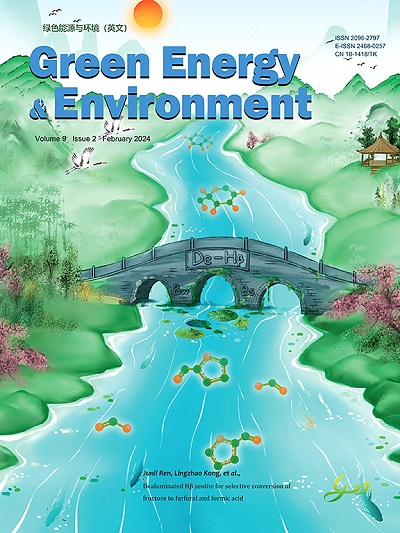三嗪-苯连接共价有机框架的合理工程,实现高效的二氧化碳光还原
IF 10.7
1区 工程技术
Q1 CHEMISTRY, PHYSICAL
引用次数: 0
摘要
为了研究结构单元如何影响 CO 的光诱导效率,我们通过在同一宿主框架中有序地加入苯环和三嗪环的方法合成了三种大的π共轭和亚胺基 COF,分别命名为 TFP-TAB、TFP-TTA 和 TTA-TTB。实验和密度泛函理论(DFT)计算的结果表明,光诱导电荷的分离和转移与 COFs 骨架中三嗪-N 的含量和共轭度密切相关。通过合理调整 COF 中苯环和三嗪环的数量和位置,可以实现高效的 CO 光还原。具体来说,TTA-TTB 具有有序交错的三嗪-苯异质结,可以抑制电子和空穴的重组概率,从而有效地固定了关键物种(COOH),降低了电位决定步骤的自由能变化,因此表现出卓越的可见光诱导光催化活性,可产生 121.7 μmol HCOOH g h。因此,这项研究有助于从分子层面阐明 COFs 中不同结构单元对固有异相光催化还原 CO 的影响。本文章由计算机程序翻译,如有差异,请以英文原文为准。

Rational engineering of triazine-benzene linked covalent-organic frameworks for efficient CO2 photoreduction
Three large π-conjugated and imine-based COFs, named TFP-TAB, TFP-TTA, and TTA-TTB, were synthesized via the ordered incorporation of benzene and triazine rings in the same host framework to study how the structural units affect the efficiency of CO photoreduction. Results from both experiments and density-functional theory (DFT) calculations indicate the separation and transfer of the photoinduced charges is highly related to the triazine-N content and the conjugation degree in the skeletons of COFs. High-efficiency CO photoreduction can be achieved by rationally adjusting the number and position of both benzene and triazine rings in the COFs. Specifically, TTA-TTB, with orderly interlaced triazine-benzene heterojunctions, can suppress the recombination probability of electrons and holes, which effectively immobilizes the key species (COOH) and lowers the free energy change of the potential-determining step, and thus exhibits a superior visible-light-induced photocatalytic activity that yields 121.7 μmol HCOOH g h. This research, therefore, helps to elucidate the effects of the different structural blocks in COFs on inherent heterogeneous photocatalysis for CO reduction at a molecular level.
求助全文
通过发布文献求助,成功后即可免费获取论文全文。
去求助
来源期刊

Green Energy & Environment
Energy-Renewable Energy, Sustainability and the Environment
CiteScore
16.80
自引率
3.80%
发文量
332
审稿时长
12 days
期刊介绍:
Green Energy & Environment (GEE) is an internationally recognized journal that undergoes a rigorous peer-review process. It focuses on interdisciplinary research related to green energy and the environment, covering a wide range of topics including biofuel and bioenergy, energy storage and networks, catalysis for sustainable processes, and materials for energy and the environment. GEE has a broad scope and encourages the submission of original and innovative research in both fundamental and engineering fields. Additionally, GEE serves as a platform for discussions, summaries, reviews, and previews of the impact of green energy on the eco-environment.
 求助内容:
求助内容: 应助结果提醒方式:
应助结果提醒方式:


